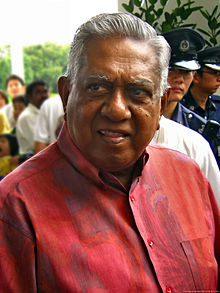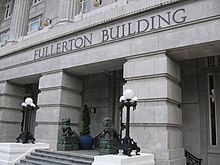
| S. R. Nathan | |
|---|---|
| செல்லப்பன் ராமநாதன் Cellappaṉ Rāmanātaṉ |
|
 |
|
| 6th President of Singapore | |
| In office 1 September 1999 – 31 August 2011 |
|
| Prime Minister | Goh Chok Tong Lee Hsien Loong |
| Preceded by | Ong Teng Cheong |
| Succeeded by | Tony Tan Keng Yam |
| Personal details | |
| Born | 3 July 1924 Singapore, Straits Settlements |
| Died | 22 August 2016 (aged 92) Singapore General Hospital, Singapore |
| Resting place | Mandai Crematorium |
| Spouse(s) | Urmila Nandey (m. 1958) |
| Children | Juthika Ramanathan Osith Ramanathan |
| Alma mater | University of Malaya |
Sellapan Ramanathan ( /ˈsɛləpən rɑːməˈnɑːðən/; 3 July 1924 – 22 August 2016), usually referred to as S. R. Nathan, was the sixth President of Singapore from 1999 to 2011, having been elected in uncontested elections in 1999 and 2005. In 2009, he surpassed Benjamin Sheares to become Singapore's longest-serving President.
Civil service career

Nathan began his career in the Singapore Civil Service as a medical social worker in 1955. He was appointed Seamen's Welfare Officer the following year. In 1962, he was seconded to the Labour Research Unit of the National Trades Union Congress (NTUC), first as Assistant Director and later as Director of the Labour Research Unit until January 1966. Nathan negotiated Singapore's membership of the Afro-Asian People's Solidarity Organisation. He later served as a member of the NTUC's Board of Trustees from 1983 to April 1988.
In February 1966, Nathan was transferred to the Ministry of Foreign Affairs. He served as Assistant Secretary and rose to be Deputy Secretary before being appointed Deputy Secretary of the Ministry of Home Affairs in January 1971. On 6 August of the same year, Nathan moved to the Ministry of Defence where he was Director of the Security and Intelligence Division (SID). In the Laju incident on 31 January 1974, members of the terrorist Japanese Red Army and the Popular Front for the Liberation of Palestine bombed petroleum tanks on Pulau Bukom off the coast of Singapore; Nathan was among a group of government officers who volunteered to be held hostage by the JRA and flown to Kuwait to secure the release of civilian hostages and ensure the terrorists' safe passage. For his bravery, in August 1974 he was awarded the Pingat Jasa Gemilang (Meritorious Service Medal).
In February 1979, Nathan returned to the Foreign Ministry and became its First Permanent Secretary until February 1982, when he left to become the Executive Chairman of the newspaper company the Straits Times Press. The appointment was viewed dimly by journalists who felt that the Government was trying to limit freedom of the press; they wore black armbands in protest. According to Nathan in a 2010 interview, " When they saw I was not doing what they expected me to do, they began to have confidence." At various times between 1982 and 1988, Nathan also held directorships of several other companies, including the Singapore Mint, The Straits Times Press (London), Singapore Press Holdings and Marshall Cavendish. He held a directorship in the Singapore International Media between September 1996 and August 1999. He was Chairman of Mitsubishi Heavy Industries Singapore, a ship-repairing and engineering joint venture with the Mitsubishi Group of Japan, from 1973 to 1986. From 1983 to April 1988, Nathan was Chairman of the Hindu Endowments Board. He was a founding member of the Singapore Indian Development Association (SINDA), and its term trustee until August 1999.
In April 1988 Nathan was appointed Singapore's High Commissioner to Malaysia, and in July 1990 he became Ambassador to the United States, serving until June 1996. On his return, Nathan was made an Ambassador-at-Large and was concurrently Director of the Institute of Defence and Strategic Studies at the Nanyang Technological University. He resigned as Ambassador and Director of the Institute on 17 August 1999 to become a candidate in the Singapore presidential election, 1999. (wikipedia)

